Specification Work Group Chairs / Specification Editors
Specification Work Group Contributors
Pre-Release Draft Industry Reviewing Companies That Provided Feedback
Revision History
1 Introduction
1.1 Purpose
1.2 Scope
1.3 Related Documents
1.4 Conventions
1.4.1 Precedence
1.4.2 Keywords
1.4.2.1 Informative
1.4.2.2 May
1.4.2.3 N/A
1.4.2.4 Normative
1.4.2.5 Optional
1.4.2.6 Reserved
1.4.2.7 Shall
1.4.2.8 Should
1.4.3 Numbering
1.5 Terms and Abbreviations
2 Overview
2.1 Introduction
2.2 USB Type-C Receptacles, Plugs and Cables
2.3 Configuration Process
2.3.1 Source-to-Sink Attach/Detach Detection
2.3.2 Plug Orientation/Cable Twist Detection
2.3.3 Initial Power (Source-to-Sink) Detection and Establishing the Data (Host-to-Device) Relationship
2.3.4 USB Type-C Vbus Current Detection and Usage
2.3.5 USB PD Communication
2.3.6 Functional Extensions
2.4 Vbus
2.5 Vconn
2.6 Hubs
3 Mechanical
3.1 Overview
3.1.1 Compliant Connectors
3.1.2 Compliant Cable Assemblies
3.1.3 Compliant USB Type-C to Legacy Cable Assemblies
3.1.4 Compliant USB Type-C to Legacy Adapter Assemblies
3.2 USB Type-C Connector Mating Interfaces
3.2.1 Interface Definition
3.2.2 Reference Designs
3.2.2.1 Receptacle Mid-Plate (Informative)
3.2.2.2 Side Latch (informative)
3.2.2.3 Internal EMC Springs and Pads (Informative)
3.2.2.4 Optional External Receptacle EMC Springs (Informative)
3.2.2.5 USB Full-Featured Type-C Plug Paddle Card (Informative)
3.2.3 Pin Assignments and Descriptions
3.3 Cable Construction and Wire Assignments
3.3.1 Cable Construction (Informative)
3.3.2 Wire Assignments
3.3.3 Wire Gauges and Cable Diameters (Informative)
3.4 Standard USB Type-C Cable Assemblies
3.4.1 USB Full-Featured Type-C Cable Assembly
3.4.2 USB 2.0 Type-C Cable Assembly
3.4.3 USB Type-C Captive Cable Assemblies
3.5 Legacy Cable Assemblies
3.5.1 USB Type-C to USB 3.1 Standard-A Cable Assembly
3.5.2 USB Type-C to USB 2.0 Standard-A Cable Assembly
3.5.3 USB Type-C to USB 3.1 Standard-B Cable Assembly
3.5.4 USB Type-C to USB 2.0 Standard-B Cable Assembly
3.5.5 USB Type-C to USB 2.0 Mini-B Cable Assembly
3.5.6 USB Type-C to USB 3.1 Micro-B Cable Assembly
3.5.7 USB Type-C to USB 2.0 Micro-B Cable Assembly
3.6 Legacy Adapter Assemblies
3.6.1 USB Type-C to USB 3.1 Standard-A Receptacle Adapter Assembly
3.6.2 USB Type-C to USB 2.0 Micro-B Receptacle Adapter Assembly
3.7 Electrical Characteristics
3.7.1 Raw Cable (Informative)
3.7.1.1 Intra-Pair Skew (Informative)
3.7.1.2 Differential Insertion Loss (Informative)
3.7.2 USB Type-C to Type-C Passive Cable Assemblies (Normative)
3.7.2.1 Recommended USB SuperSpeed Passive Cable Assembly Characteristics
3.7.2.1.1 Differential Insertion Loss (Informative)
3.7.2.1.2 Differential Return Loss (Informative)
3.7.2.1.3 Differential Near-End and Far-End Crosstalk between SuperSpeed Pairs (Informative)
3.7.2.1.4 Differential Crosstalk between USB D+/D− and USB SuperSpeed Pairs (Informative)
3.7.2.2 Normative SuperSpeed Passive Cable Assembly Requirements
3.7.2.2.1 Insertion Loss Fit at Nyquist Frequencies (Normative)
3.7.2.2.2 Integrated Multi-reflection (Normative)
3.7.2.2.3 Integrated Crosstalk between SuperSpeed Pairs (Normative)
3.7.2.2.4 Integrated Return Loss (Normative)
3.7.2.2.5 Differential-to-Common-Mode Conversion (Normative)
3.7.2.3 Low-Speed Signal Requirements (Normative)
3.7.2.3.1 CC to USB D+/D− (Normative)
3.7.2.3.2 Vbus Coupling to SBU_A/SBU_B, CC, and USB D+/D− (Normative)
3.7.2.3.3 Coupling between SBU_A and SBU_B (Normative)
3.7.2.3.4 Coupling between SBU_A/SBU_B and CC (Normative)
3.7.2.3.5 Coupling between SBU_A/SBU_B and USB D+/D− (Normative)
3.7.2.4 USB D+/D− Signal Requirements (Normative)
3.7.2.5 Vbus DC Voltage Tolerance (Normative)
3.7.3 Mated Connector (Informative)
3.7.3.1 Differential Impedance (Informative)
3.7.3.2 Mated Connector Recommended Differential S-Parameter and Signal Integrity Characteristics (Informative)
3.7.4 USB Type-C to Legacy Cable Assemblies (Normative)
3.7.4.1 USB 2.0-only Cable Assemblies (Normative)
3.7.4.2 USB 3.1 Gen 2 Cable Assemblies (Normative)
3.7.4.3 Compliant USB Legacy Plugs used in USB Type-C to Legacy Cable Assemblies
3.7.4.3.1 Contact Material Requirements for USB Type-C to USB Micro-B Assemblies
3.7.4.3.2 Contact Current Ratings for USB Standard-A, USB Standard-B and USB Micro-B Connector Mated Pairs (EIA 364-70, Method 2)
3.7.5 USB Type-C to USB Legacy Adapter Assemblies (Normative)
3.7.5.1 USB 2.0 Type-C Plug to USB 2.0 Micro-B Receptacle Adapter Assembly (Normative)
3.7.5.2 USB Full-Featured Type-C Plug to USB 3.1 Standard-A Receptacle Adapter Assembly (Normative)
3.7.5.3 Compliant USB Legacy Receptacles used in USB Type-C to Legacy Adapter Assemblies
3.7.5.3.1 Contact Material Requirements
3.7.5.3.2 Contact Current Ratings
3.7.6 Shielding Effectiveness Requirements (Normative)
3.7.7 DC Electrical Requirements (Normative)
3.7.7.1 Low Level Contact Resistance (EIA 364-23B)
3.7.7.2 Dielectric Strength (EIA 364-20)
3.7.7.3 Insulation Resistance (EIA 364-21)
3.7.7.4 Contact Current Rating
3.7.7.5 DC Resistance of D+ and D−
3.8 Mechanical and Environmental Requirements (Normative)
3.8.1 Mechanical Requirements
3.8.1.1 Insertion Force (EIA 364-13)
3.8.1.2 Extraction Force (EIA 364-13)
3.8.1.3 Durability or Insertion/Extraction Cycles (EIA 364-09)
3.8.1.4 Cable Flexing (EIA 364-41, Condition 1)
3.8.1.5 Cable Pull-Out (EIA 364-38, Method A)
3.8.1.6 4-Axis Continuity Test
3.8.1.7 Wrenching Strength
3.8.1.8 Restriction of Hazardous Substances
3.8.2 Environmental Requirements
3.8.2.1 Reference Materials (Informative)
3.9 Docking Applications (Informative)
3.10 Implementation Notes and Design Guides
3.10.1 EMC Management (Informative)
3.10.2 Stacked and Side-by-Side Connector Physical Spacing (Informative)
3.10.3 Cable Mating Considerations (Informative)
4 Functional
4.1 Signal Summary
4.2 Signal Pin Descriptions
4.2.1 SuperSpeed USB Pins
4.2.2 USB 2.0 Pins
4.2.3 Auxiliary Signal Pins
4.2.4 Power and Ground Pins
4.2.5 Configuration Pins
4.3 Sideband Use (SBU)
4.4 Power and Ground
4.4.1 IR Drop
4.4.2 Vbus
4.4.3 Vconn
4.5 Configuration Channel (CC)
4.5.1 Architectural Overview
4.5.1.1 USB Data Bus Interface and USB Type-C Plug Flip-ability
4.5.1.2 Connecting Sources and Sinks
4.5.1.2.1 Detecting a Valid Source-to-Sink Connection
4.5.1.3 Configuration Channel Functional Models
4.5.1.3.1 Source Configuration Channel Functional Model
4.5.1.3.2 Sink Configuration Channel Functional Model
4.5.1.3.3 Dual-Role-Power (DRP) Configuration Channel Functional Model
4.5.1.4 USB Type-C Port Power Roles and Role Swapping Mechanisms
4.5.1.4.1 USB Type-C State-Machine-Based Role Swapping
4.5.1.4.2 USB PD-based Power Role, Data Role and Vconn Swapping
4.5.1.4.3 Power Role Behavioral Model Summary
4.5.2 CC Functional and Behavioral Requirements
4.5.2.1 Connection State Diagrams
4.5.2.2 Connection State Machine Requirements
4.5.2.2.1 Disabled State
4.5.2.2.1.1 Disabled State Requirements
4.5.2.2.1.2 Exiting From Disabled State
4.5.2.2.2 ErrorRecovery State
4.5.2.2.2.1 ErrorRecovery State Requirements
4.5.2.2.2.2 Exiting From ErrorRecovery State
4.5.2.2.3 Unattached.SNK State
4.5.2.2.3.1 Unattached.SNK Requirements
4.5.2.2.3.2 Exiting from Unattached.SNK State
4.5.2.2.4 AttachWait.SNK State
4.5.2.2.4.1 AttachWait.SNK Requirements
4.5.2.2.4.2 Exiting from AttachWait.SNK State
4.5.2.2.5 Attached.SNK State
4.5.2.2.5.1 Attached.SNK Requirements
4.5.2.2.5.2 Exiting from Attached.SNK State
4.5.2.2.6 UnattachedWait.SRC State
4.5.2.2.6.1 UnattachedWait.SRC Requirements
4.5.2.2.6.2 Exiting from UnattachedWait.SRC State
4.5.2.2.7 Unattached.SRC State
4.5.2.2.7.1 Unattached.SRC Requirements
4.5.2.2.7.2 Exiting from Unattached.SRC State
4.5.2.2.8 AttachWait.SRC State
4.5.2.2.8.1 AttachWait.SRC Requirements
4.5.2.2.8.2 Exiting from AttachWait.SRC State
4.5.2.2.9 Attached.SRC State
4.5.2.2.9.1 Attached.SRC Requirements
4.5.2.2.9.2 Exiting from Attached.SRC State
4.5.2.2.10 Try.SRC State
4.5.2.2.10.1 Try.SRC Requirements
4.5.2.2.10.2 Exiting from Try.SRC State
4.5.2.2.11 TryWait.SNK State
4.5.2.2.11.1 TryWait.SNK Requirements
4.5.2.2.11.2 Exiting from TryWait.SNK State
4.5.2.2.12 Try.SNK State
4.5.2.2.12.1 Try.SNK Requirements
4.5.2.2.12.2 Exiting from Try.SNK State
4.5.2.2.13 TryWait.SRC State
4.5.2.2.13.1 TryWait.SRC Requirements
4.5.2.2.13.2 Exiting from TryWait.SRC State
4.5.2.2.14 Unattached.Accessory State
4.5.2.2.14.1 Unattached.Accessory Requirements
4.5.2.2.14.2 Exiting from Unattached.Accessory State
4.5.2.2.15 AttachWait.Accessory State
4.5.2.2.15.1 AttachWait.Accessory Requirements
4.5.2.2.15.2 Exiting from AttachWait.Accessory State
4.5.2.2.16 AudioAccessory State
4.5.2.2.16.1 AudioAccessory Requirements
4.5.2.2.16.2 Exiting from AudioAccessory State
4.5.2.2.17 UnorientedDebugAccessory.SRC
4.5.2.2.17.1 UnorientedDebugAccessory.SRC Requirements
4.5.2.2.17.2 Exiting from UnorientedDebugAccessory.SRC State
4.5.2.2.18 OrientedDebugAccessory.SRC State
4.5.2.2.18.1 OrientedDebugAccessory.SRC State Requirements
4.5.2.2.18.2 Exiting from OrientedDebugAccessory.SRC State
4.5.2.2.19 DebugAccessory.SNK
4.5.2.2.19.1 DebugAccessory.SNK Requirements
4.5.2.2.19.2 Exiting from DebugAccessory.SNK State
4.5.2.2.20 PoweredAccessory State
4.5.2.2.20.1 PoweredAccessory Requirements
4.5.2.2.20.2 Exiting from PoweredAccessory State
4.5.2.2.21 Unsupported.Accessory State
4.5.2.2.21.1 Unsupported.Accessory Requirements
4.5.2.2.21.2 Exiting from Unsupported.Accessory
4.5.2.2.22 CTUnattached.VPD State
4.5.2.2.22.1 CTUnattached.VPD Requirements
4.5.2.2.22.2 Exiting from CTUnattached.VPD
4.5.2.2.23 CTAttachWait.VPD State
4.5.2.2.23.1 CTAttachWait.VPD Requirements
4.5.2.2.23.2 Exiting from CTAttachWait.VPD
4.5.2.2.24 CTAttached.VPD State
4.5.2.2.24.1 CTAttached.VPD Requirements
4.5.2.2.24.2 Exiting from CTAttached.VPD
4.5.2.2.25 CTDisabled.VPD State
4.5.2.2.25.1 CTDisabled.VPD Requirements
4.5.2.2.25.2 Exiting from CTDisabled.VPD
4.5.2.2.26 CTUnattached.SNK State
4.5.2.2.26.1 CTUnattached.SNK Requirements
4.5.2.2.26.2 Exiting from CTUnattached.SNK
4.5.2.2.27 CTAttached.SNK State
4.5.2.2.27.1 CTAttached.SNK Requirements
4.5.2.2.27.2 Exiting from CTAttached.SNK
4.5.2.2.28 CTUnattached.Unsupported State
4.5.2.2.28.1 CTUnattached.Unsupported Requirements
4.5.2.2.28.2 Exiting from CTUnattached.Unsupported
4.5.2.2.29 CTAttachWait.Unsupported State
4.5.2.2.29.1 CTAttachWait.Unsupported Requirements
4.5.2.2.29.2 Exiting from CTAttachWait.Unsupported
4.5.2.2.30 CTTry.SNK State
4.5.2.2.30.1 CTTry.SNK Requirements
4.5.2.2.30.2 Exiting from CTTry.SNK
4.5.2.2.31 CTAttached.Unsupported State
4.5.2.2.31.1 CTAttached.Unsupported Requirements
4.5.2.2.31.2 Exiting from CTAttached.Unsupported
4.5.2.3 Sink Power Sub-State Requirements
4.5.2.3.1 PowerDefault.SNK Sub-State
4.5.2.3.1.1 PowerDefault.SNK Requirements
4.5.2.3.1.2 Exiting from PowerDefault.SNK
4.5.2.3.2 Power1.5.SNK Sub-State
4.5.2.3.2.1 Power1.5.SNK Requirements
4.5.2.3.2.2 Exiting from Power1.5.SNK
4.5.2.3.3 Power3.0.SNK Sub-State
4.5.2.3.3.1 Power3.0.SNK Requirements
4.5.2.3.3.2 Exiting from Power3.0.SNK
4.5.2.4 Cable State Machine Requirements
4.5.2.4.1 Cable Power On State
4.5.2.4.1.1 Cable Power On State Requirements
4.5.2.4.1.2 Exiting from Cable Power On State
4.5.2.4.2 Unassigned SOP State
4.5.2.4.2.1 Unassigned SOP State Requirements
4.5.2.4.2.2 Exiting from Unassigned SOP State
4.5.2.4.3 Assign SOP’ State
4.5.2.4.3.1 Assign SOP’ State Requirements
4.5.2.4.3.2 Exiting from Assign SOP’ State
4.5.2.4.4 Assign SOP” State (Optional Normative)
4.5.2.4.4.1 Assign SOP” State Requirements
4.5.2.4.4.2 Exiting from SOP” State
4.5.2.5 Connection States Summary
4.5.3 USB Port Interoperability Behavior
4.5.3.1 USB Type-C Port to USB Type-C Port Interoperability Behaviors
4.5.3.1.1 Source to Sink Behavior
4.5.3.1.2 Source to DRP Behavior
4.5.3.1.3 DRP to Sink Behavior
4.5.3.1.4 DRP to DRP Behavior
4.5.3.1.5 Source to Source Behavior
4.5.3.1.6 Sink to Sink Behavior
4.5.3.1.7 DRP to Vconn-Powered USB Device (VPD) Behavior
4.5.3.1.8 DRP to Charge-Through Vconn-Powered USB Device (CTVPD) Behavior
4.5.3.2 USB Type-C port to Legacy Port Interoperability Behaviors
4.5.3.2.1 Source to Legacy Device Port Behavior
4.5.3.2.2 Legacy Host Port to Sink Behavior
4.5.3.2.3 DRP to Legacy Device Port Behavior
4.5.3.2.4 Legacy Host Port to DRP Behavior
4.6 Power
4.6.1 Power Requirements during USB Suspend
4.6.1.1 Vbus Requirements during USB Suspend
4.6.1.2 Vconn Requirements during USB Suspend
4.6.2 Vbus Power Provided Over a USB Type-C Cable
4.6.2.1 USB Type-C Current
4.6.2.2 USB Battery Charging 1.2
4.6.2.3 Proprietary Power Source
4.6.2.4 USB Power Delivery
4.6.2.5 Charge-Through Vconn-Powered USB Device (CTVPD) Current Limitations
4.7 USB Hubs
4.8 Power Sourcing and Charging
4.8.1 DFP as a Power Source
4.8.1.1 USB-based Chargers with USB Type-C Receptacles
4.8.1.2 USB-based Chargers with USB Type-C Captive Cables
4.8.2 Non-USB Charging Methods
4.8.3 Sinking Host
4.8.4 Sourcing Device
4.8.5 Charging a System with a Dead Battery
4.8.6 USB Type-C Multi-Port Chargers
4.8.6.1 General Requirements
4.8.6.2 Multi-Port Charger Behaviors
4.8.6.3 Multi-Port Charger Port Labeling
4.8.6.4 Multi-Port Charger that include USB Data Hub Functionality
4.9 Electronically Marked Cables
4.9.1 Parameter Values
4.9.2 Active Cables
4.10 Vconn-Powered Accessories (VPAs) and Vconn-Powered USB Devices (VPDs)
4.10.1 Vconn-Powered Accessories (VPAs)
4.10.2 Vconn-Powered USB Devices (VPDs)
4.11 Parameter Values
4.11.1 Termination Parameters
4.11.2 Timing Parameters
4.11.3 Voltage Parameters
5 Functional Extensions
5.1 Alternate Modes
5.1.1 Alternate Mode Architecture
5.1.2 Alternate Mode Requirements
5.1.2.1 Alternate Mode Pin Reassignment
5.1.2.2 Alternate Mode Electrical Requirements
5.1.3 Parameter Values
5.1.4 Example Alternate Mode – USB DisplayPort™ Dock
5.1.4.1 USB DisplayPort Dock Example
5.1.4.2 Functional Overview
5.1.4.3 Operational Summary
6 Active Cables
6.1 USB Type-C State Machine
6.2 USB PD Requirements
6.2.1 Active Cable USB PD Requirements
6.2.1.1 SOP’ and SOP” Requirements
6.2.1.2 Discovering Cable Characteristics
6.2.1.3 Cable Status
6.2.2 USB PD Messages for OIAC
6.2.2.1 USB PD Message Handling on Initial Connection
6.2.2.2 USB PD Message Handling in the Active State
6.2.2.2.1 USB PD Messages Which Do Not Traverse the Cable in the Active State
6.2.2.2.2 USB PD Messages Which Do Traverse the Cable in the Active State
6.2.2.3 USB PD Reset Handling
6.2.2.4 Internal Cable Messages
6.2.2.4.1 MSG_Keep_Alive
6.2.2.4.2 MSG_Keep_Alive_ACK
6.2.2.4.3 MSG_Port_Capabilities
6.2.2.4.4 MSG_Cable_Config
6.2.2.4.5 MSG_Release_Remote_SourceCap_GoodCRC
6.2.2.4.6 MSG_DR_Swap_Init
6.2.2.4.7 MSG_DR_Swap_Reject
6.2.2.4.8 MSG_DR_Swap_Accept
6.2.2.4.9 MSG_Force_Detach
6.2.2.4.10 MSG_Hard_Reset
6.2.2.4.11 MSG_Acknowledgement
6.2.2.5 Data Role Swap in Active State
6.2.3 Short Active Cable Behaviors in Response to Power Delivery Events
6.2.3.1 Data Role Swap
6.2.3.2 Power Role Swap
6.2.3.3 Vconn Swap
6.2.3.4 Fast Role Swap
6.3 OIAC Connection Flow and State Diagrams
6.3.1 OIAC Connection Flow – Discovery – Phase 1
6.3.2 OIAC Connection Flow – Reboot – Phase 2
6.3.3 OIAC Connection Flow – Configuration – Phase 3
6.3.4 OIAC Connection State Diagram Master
6.3.4.1 Detached State (M0)
6.3.4.2 Remote Handshake State (M1)
6.3.4.2.1 Entry to Remote Handshake
6.3.4.2.2 Exit from Remote Handshake
6.3.4.3 Master Initial PD Contract State (M2)
6.3.4.3.1 Entry to Master Initial DP Contract
6.3.4.3.2 Exit from Master Initial DP Contract
6.3.4.4 Local DR Swap Test State (M3)
6.3.4.4.1 Entry to Local DR Swap Test
6.3.4.4.2 Exit from Local DR Swap Test
6.3.4.5 Remote DR Swap Test State (M4)
6.3.4.5.1 Entry to Remote DR Swap Test
6.3.4.5.2 Exit from Remote DR Swap Test
6.3.4.6 Error – USB2 Billboard (M5)
6.3.4.6.1 Entry to Error – USB2 Billboard
6.3.4.6.2 Exit from Error – USB2 Billboard
6.3.4.7 Reboot Sequence State (M6)
6.3.4.7.1 Entry to Reboot Sequence
6.3.4.7.2 Exit from Reboot Sequence
6.3.4.8 Force Detach State (M7)
6.3.4.8.1 Entry to Force Detach
6.3.4.8.2 Exit from Force Detach
6.3.4.9 Active USB PD Contract 1 State (M8)
6.3.4.9.1 Entry to Active USB PD Contract 1
6.3.4.9.2 Exit from Active USB PD Contract 1
6.3.4.10 DR Swap State (M9)
6.3.4.10.1 Entry to DR Swap
6.3.4.10.2 Exit from DR Swap
6.3.4.11 Release Remote Source_Cap GoodCRC 1 State (M10)
6.3.4.11.1 Entry to Release Remote Source_Cap GoodCRC 1
6.3.4.11.2 Exit from Release Remote Source_Cap GoodCRC 1
6.3.4.12 Active USB PD Contract 2 State (M11)
6.3.4.12.1 Entry to Active USB PD Contract 2
6.3.4.12.2 Exit from Active USB PD Contract 2
6.3.4.13 Release Remote Source_Cap GoodCRC 2 State (M12)
6.3.4.13.1 Entry to Release Remote Source_Cap GoodCRC 2
6.3.4.13.2 Exit from Release Remote Source_Cap GoodCRC 2
6.3.4.14 Error – USB2 Billboard + Complete Reset (M13)
6.3.4.14.1 Entry to Error – USB2 Billboard + Complete Reset (M13)
6.3.4.14.2 Exit from Error – USB2 Billboard + Complete Reset (M13 B/C)
6.3.4.14.3 WatchDog Timer Entry
6.3.4.15 Final System Configuration Verification (M14)
6.3.4.15.1 Entry to Final System Configuration Verification
6.3.4.15.2 Exit from Final System Configuration Verification
6.3.5 OIAC Connection State Diagram Slave
6.3.5.1 Detached State (S0)
6.3.5.2 Remote Handshake State (S1)
6.3.5.2.1 Entry to Remote Handshake
6.3.5.2.2 Exit from Remote Handshake
6.3.5.3 Slave Initial DP Contract (S2)
6.3.5.3.1 Entry to Slave Initial DP Contract
6.3.5.3.2 Exit from Slave Initial DP Contract
6.3.5.4 DR Swap (S3)
6.3.5.4.1 Entry to DR Swap
6.3.5.4.2 Exit from DR Swap
6.3.5.5 Force Detach (S4)
6.3.5.5.1 Entry to Force Detach
6.3.5.5.2 Exit from Force Detach
6.3.5.6 Send Repeated Cable Config (S5)
6.3.5.6.1 Entry to Send Repeated Cable Config
6.3.5.6.2 Exit from Send Repeated Cable Config
6.3.5.7 Phase 3 PD Contract (S6)
6.3.5.7.1 Entry to Phase 3 PD Contract
6.3.5.7.2 Exit from Phase 3 PD Contract
6.3.5.8 Error – USB2 Billboard (S7)
6.3.5.8.1 Entry to Error – USB2 Billboard
6.3.5.8.2 Exit from Error – USB2 Billboard
6.3.5.9 Phase 3 DR Swap State (S8)
6.3.5.9.1 Entry to Phase 3 DR Swap
6.3.5.9.2 Exit from Phase 3 DR Swap
6.3.5.10 Error – USB2 Billboard + Complete RESET (S9)
6.3.5.10.1 Entry to Error – USB2 Billboard + Complete RESET
6.3.5.10.2 Exit from Error – USB2 Billboard + Complete RESET
6.3.5.10.3 WatchDog Timer Entry
6.3.5.11 Final System Configuration Verification (S10)
6.3.5.11.1 Entry to Final System Configuration Verification
6.3.5.11.2 Exit from Final System Configuration Verification
6.4 Active Cable Power Requirements
6.4.1 Vbus Requirements
6.4.2 OIAC Vbus Requirements
6.4.2.1 OIAC Vbus Requirements on Initial Connection
6.4.3 USB PD Rules in Active State
6.4.4 Vconn Requirements
6.5 Mechanical
6.5.1 Thermal
6.5.1.1 Thermal Shutdown
6.5.1.2 Maximum Skin Temperature
6.5.1.3 Thermal Reporting
6.5.2 Plug Spacing
6.6 Electrical Requirements
6.6.1 Shielding Effectiveness Requirement
6.6.2 Low Speed Signal Requirement
6.6.2.1 CC Channel Requirements
6.6.2.2 SBU Requirements
6.6.2.2.1 Short Active Cables
6.6.2.2.2 Optically Isolated Cables
6.6.3 USB 2.0
6.6.3.1 Short Active Cables
6.6.3.2 Optically Isolated Active Cables
6.6.4 USB 3.2
6.6.4.1 USB 3.2 Active Cable Architectures
6.6.4.2 USB 3.2 Power-on and Rx.Detect
6.6.4.3 USB 3.2 U0 Delay
6.6.4.3.1 OIAC Legacy Adapter
6.6.4.4 USB 3.2 U-State Power Requirements
6.6.4.5 USB 3.2 U-State Exit Latency
6.6.4.6 USB 3.2 Signal Swing
6.6.4.6.1 TP1 – Active Cable Input Stressed Source
6.6.4.6.2 TP2 – Active Cable Input (Informative)
6.6.4.6.3 TP3 – Active Cable Output (Informative)
6.6.4.6.4 TP4 – Active Cable Output
6.6.5 Return Loss
6.7 Active Cables That Support Alternate Modes
6.7.1 Discover SVIDs
6.7.2 Discover Modes
6.7.3 Enter/Exit Modes
6.7.4 Power in Alternate Modes
A Audio Adapter Accessory Mode
A.1 Overview
A.2 Detail
A.3 Electrical Requirements
A.4 Example Implementations
A.4.1 Passive 3.5 mm to USB Type-C Adapter – Single Pole Detection Switch
A.4.2 3.5 mm to USB Type-C Adapter Supporting 500 mA Charge-Through
B Debug Accessory Mode
B.1 Overview
B.2 Functional
B.2.1 Signal Summary
B.2.2 Port Interoperability
B.2.3 Debug Accessory Mode Entry
B.2.3.1 Detecting a Valid DTS-to-TS Connection
B.2.4 Connection State Diagrams
B.2.4.1 Connection State Machine Requirements
B.2.4.1.1 Exiting From ErrorRecovery State
B.2.4.1.2 UnattachedDeb.SNK State
B.2.4.1.2.1 UnattachedDeb.SNK Requirements
B.2.4.1.2.2 Exiting from UnattachedDeb.SNK State
B.2.4.1.3 AttachWaitDeb.SNK State
B.2.4.1.3.1 AttachWaitDeb.SNK Requirements
B.2.4.1.3.2 Exiting from AttachWaitDeb.SNK State
B.2.4.1.4 AttachedDeb.SNK State
B.2.4.1.4.1 AttachedDeb.SNK Requirements
B.2.4.1.4.2 Exiting from AttachedDeb.SNK State
B.2.4.1.5 UnattachedDeb.SRC State
B.2.4.1.5.1 UnattachedDeb.SRC Requirements
B.2.4.1.5.2 Exiting from UnattachedDeb.SRC State
B.2.4.1.6 AttachWaitDeb.SRC State
B.2.4.1.6.1 AttachWaitDeb.SRC Requirements
B.2.4.1.6.2 Exiting from AttachWaitDeb.SRC State
B.2.4.1.7 AttachedDeb.SRC State
B.2.4.1.7.1 AttachedDeb.SRC Requirements
B.2.4.1.7.2 Exiting from AttachedDeb.SRC State
B.2.4.1.8 TryDeb.SRC State
B.2.4.1.8.1 TryDeb.SRC Requirements
B.2.4.1.8.2 Exiting from TryDeb.SRC State
B.2.4.1.9 TryWaitDeb.SNK State
B.2.4.1.9.1 TryWaitDeb.SNK Requirements
B.2.4.1.9.2 Exiting from TryWaitDeb.SNK State
B.2.4.2 Power Sub-State Requirements
B.2.4.2.1 TS Sink Power Sub-State Requirements
B.2.4.2.2 PowerDefaultDeb.SNK Sub-State
B.2.4.2.2.1 PowerDefaultDeb.SNK Requirements
B.2.4.2.2.2 Exiting from PowerDefaultDeb.SNK
B.2.4.2.3 Power1.5Deb.SNK Sub-State
B.2.4.2.3.1 Power1.5Deb.SNK Requirements
B.2.4.2.3.2 Exiting from Power1.5Deb.SNK
B.2.4.2.4 Power3.0Deb.SNK Sub-State
B.2.4.2.4.1 Power3.0Deb.SNK Requirements
B.2.4.2.4.2 Exiting from Power3.0Deb.SNK
B.2.4.2.5 DTS Sink Power Sub-State Requirements
B.2.4.3 Connection States Summary
B.2.5 DTS Port Interoperability Behavior
B.2.5.1 DTS Port to TS Port Interoperability Behaviors
B.2.5.1.1 DTS Source to TS Sink Behavior
B.2.5.1.2 DTS Source to TS DRP Behavior
B.2.5.1.3 DTS Sink to TS Source Behavior
B.2.5.1.4 DTS Sink to TS DRP Behavior
B.2.5.1.5 DTS DRP to TS Sink Behavior
B.2.5.1.6 DTS DRP to TS DRP Behavior
B.2.5.1.7 DTS DRP to TS Source Behavior
B.2.5.2 DTS Port to non-DAM TS Port Interoperability Behaviors
B.2.5.2.1 DTS Source to non-DAM TS Sink Behavior
B.2.5.2.2 DTS Source to non-DAM TS DRP Behavior
B.2.5.2.3 DTS Sink to non-DAM TS Source Behavior
B.2.5.2.4 DTS Sink to non-DAM TS DRP Behavior
B.2.5.2.5 DTS DRP to non-DAM TS Sink Behavior
B.2.5.2.6 DTS DRP to non-DAM TS DRP Behavior
B.2.5.2.7 DTS DRP to non-DAM TS Source Behavior
B.2.5.2.8 DTS Sink to non-DAM TS Sink with Accessory Support Behavior
B.2.6 Orientation Detection
B.2.6.1 Orientation Detection using Rd and/or Rp Values
B.2.6.1.1 Orientation Detection with DTS as a Source
B.2.6.1.2 Orientation Detection with DTS as a Sink
B.3 Security/Privacy Requirements:
C USB Type-C Digital Audio
C.1 Overview
C.2 USB Type-C Digital Audio Specifications
D Thermal Design Considerations for Active Cables
D.1 Introduction
D.2 Model
D.2.1 Assumptions
D.2.2 Model Architecture
D.2.3 Heat Sources
D.2.4 Heat Flow
D.3 USB 3.2 Single Lane Active Cable
D.3.1 USB 3.2 Single-Lane Active Cable Design Considerations
D.3.1.1 USB 3.2 Single-Lane Active Cable in a Single Port Configuration
D.3.1.2 USB 3.2 Single-Lane Active Cable in a Multiple Port Configuration
D.3.1.2.1 USB 3.2 Single-Lane 3A Active Cable in a 3-Port Configuration
D.3.1.2.2 USB 3.2 Single-Lane 5A Active Cable in a 3-Port Configuration
D.4 Dual-Lane Active Cables
D.4.1 USB 3.2 Dual-Lane Active Cable Design Considerations
D.4.1.1 USB 3.2 Dual-Lane Active Cable in a Single Port Configuration
D.4.1.2 Impact of Over-mold Power PO and Thermal Boundary Temperature TMB
D.4.1.3 Dongle Cable
D.4.2 USB 3.2 Dual-Lane Active Cable in a Multi-Port Configuration
D.4.2.1 USB 3.2 Dual-Lane 3A Active Cable in a 3-Port Configuration
D.4.2.2 USB 3.2 Dual-Lane 5A Active Cable in a 3-Port Configuration
D.5 USB 3.2 Host and Device Design Considerations
D.5.1 Heat Spreading or Heat Sinking from Host or Device
D.5.2 Motherboard Temperature Control
D.5.3 Wider Port Spacing for Multi-Port Applications
D.5.4 Power Policies

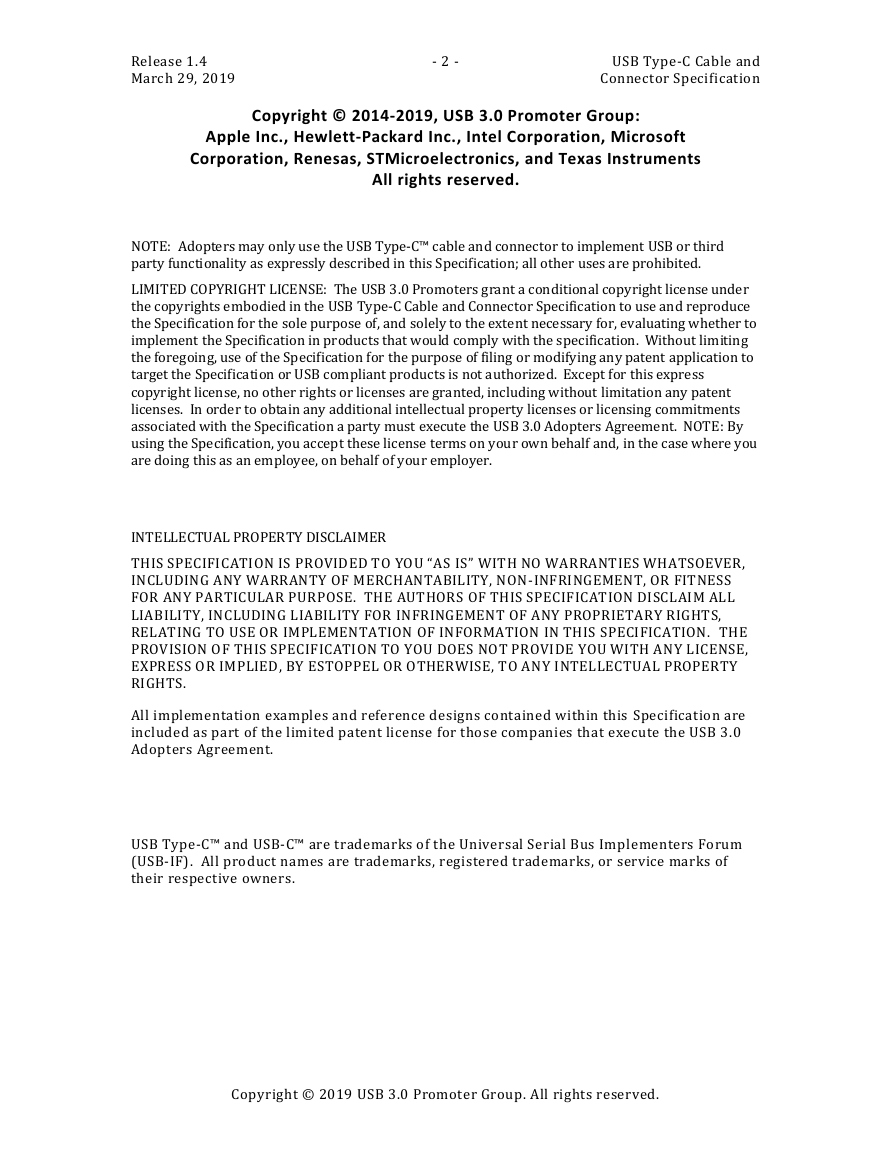

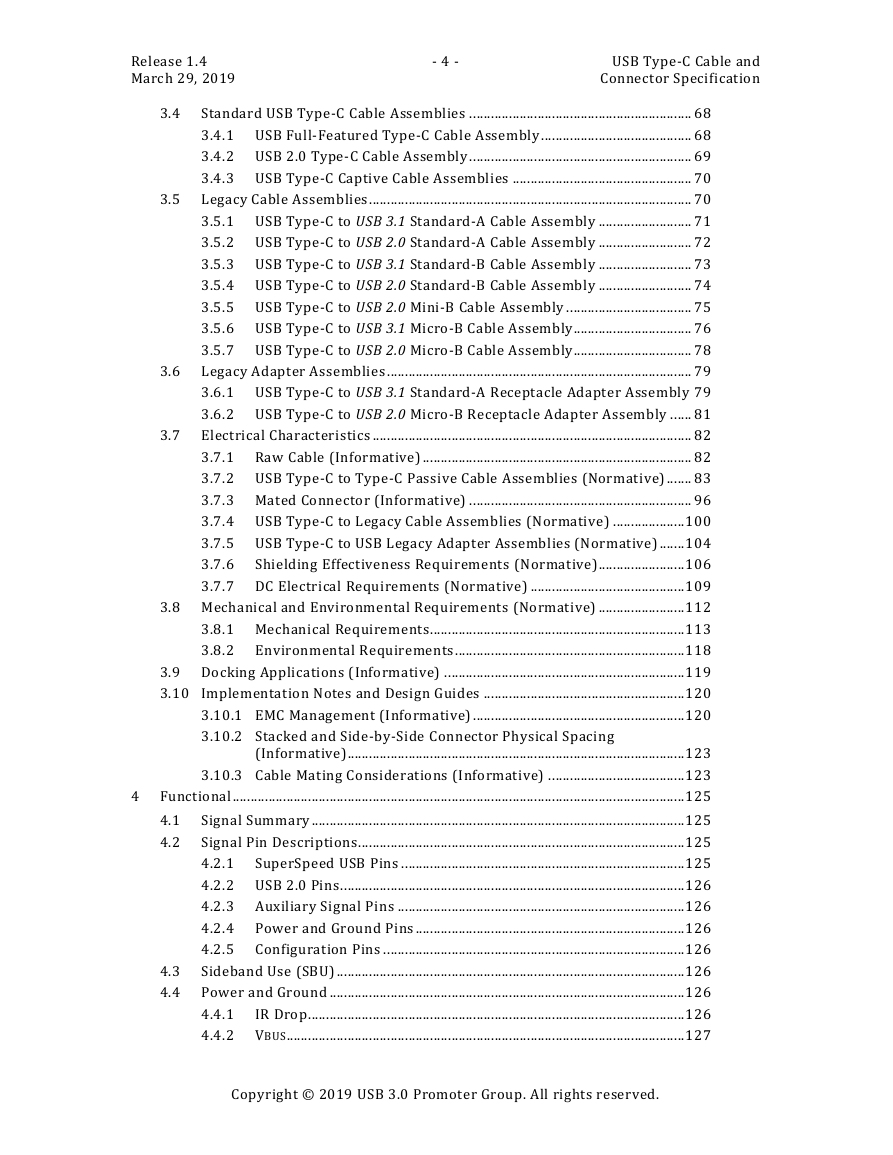
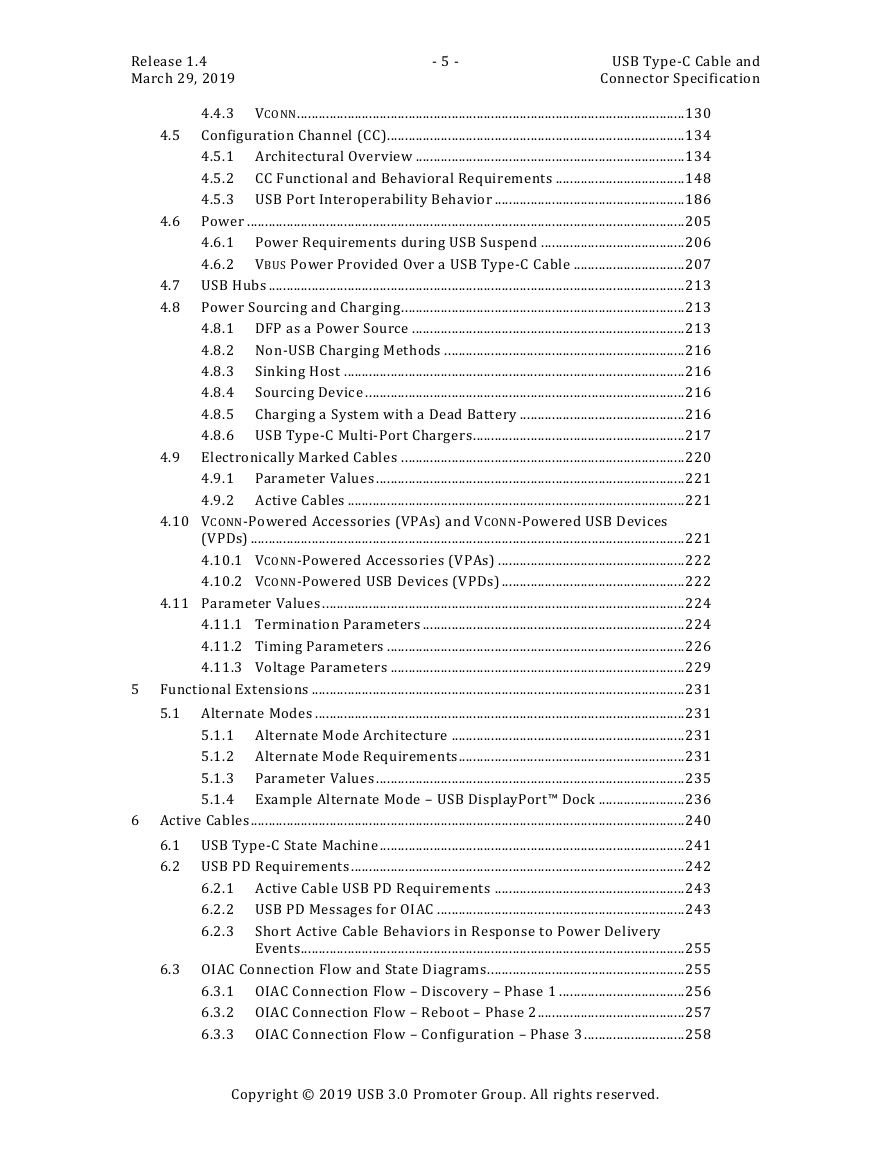
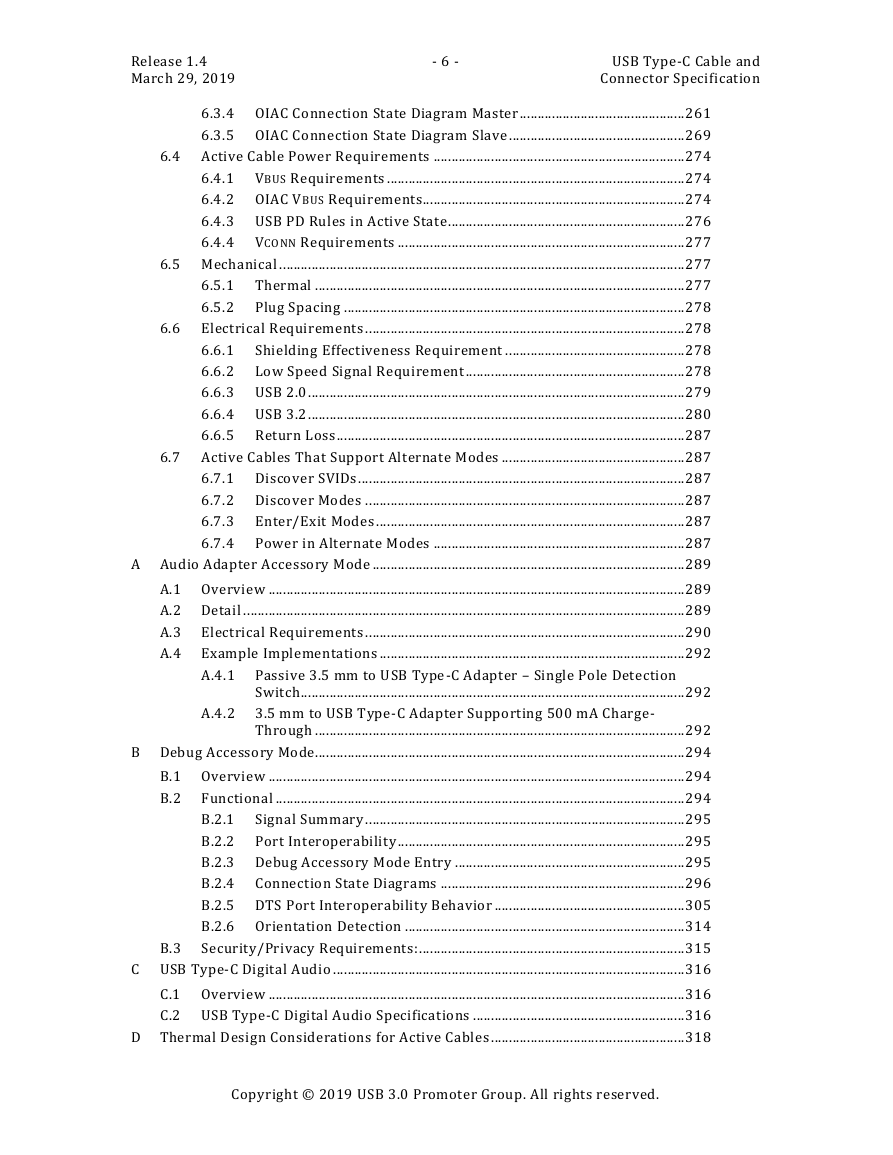
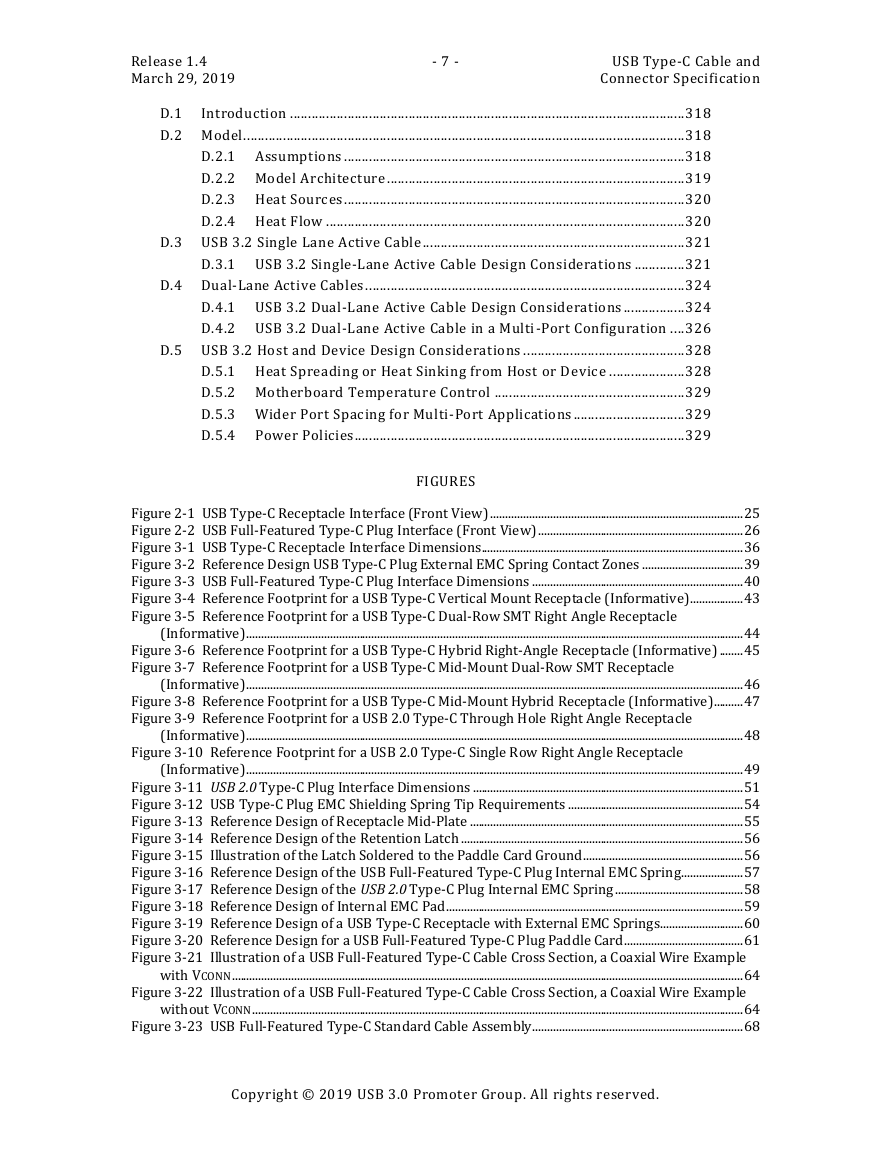









 2023年江西萍乡中考道德与法治真题及答案.doc
2023年江西萍乡中考道德与法治真题及答案.doc 2012年重庆南川中考生物真题及答案.doc
2012年重庆南川中考生物真题及答案.doc 2013年江西师范大学地理学综合及文艺理论基础考研真题.doc
2013年江西师范大学地理学综合及文艺理论基础考研真题.doc 2020年四川甘孜小升初语文真题及答案I卷.doc
2020年四川甘孜小升初语文真题及答案I卷.doc 2020年注册岩土工程师专业基础考试真题及答案.doc
2020年注册岩土工程师专业基础考试真题及答案.doc 2023-2024学年福建省厦门市九年级上学期数学月考试题及答案.doc
2023-2024学年福建省厦门市九年级上学期数学月考试题及答案.doc 2021-2022学年辽宁省沈阳市大东区九年级上学期语文期末试题及答案.doc
2021-2022学年辽宁省沈阳市大东区九年级上学期语文期末试题及答案.doc 2022-2023学年北京东城区初三第一学期物理期末试卷及答案.doc
2022-2023学年北京东城区初三第一学期物理期末试卷及答案.doc 2018上半年江西教师资格初中地理学科知识与教学能力真题及答案.doc
2018上半年江西教师资格初中地理学科知识与教学能力真题及答案.doc 2012年河北国家公务员申论考试真题及答案-省级.doc
2012年河北国家公务员申论考试真题及答案-省级.doc 2020-2021学年江苏省扬州市江都区邵樊片九年级上学期数学第一次质量检测试题及答案.doc
2020-2021学年江苏省扬州市江都区邵樊片九年级上学期数学第一次质量检测试题及答案.doc 2022下半年黑龙江教师资格证中学综合素质真题及答案.doc
2022下半年黑龙江教师资格证中学综合素质真题及答案.doc